Librela Injection for Dogs: Benefits, Side Effects, and Usage
Librela is a monoclonal antibody (mAb), also known as Bedinvetmab injection. This medication is primarily made from the chemical Bedinvetmab and is used to reduce pain associated with osteoarthritis in dogs. The U.S. FDA (Food and Drug Administration) approved Librela Injection on May 5, 2023, and it was launched in the market on July 14, 2023. It is the first monoclonal antibody (mAb) approved by the FDA for the treatment of pain in dogs.
Prior to this, on January 13, 2022, the FDA approved Solensia (frunevetmab injection) for the treatment of pain associated with osteoarthritis or arthritis in cats. It was the first monoclonal antibody (mAb) approved by the FDA for use in any animal species.
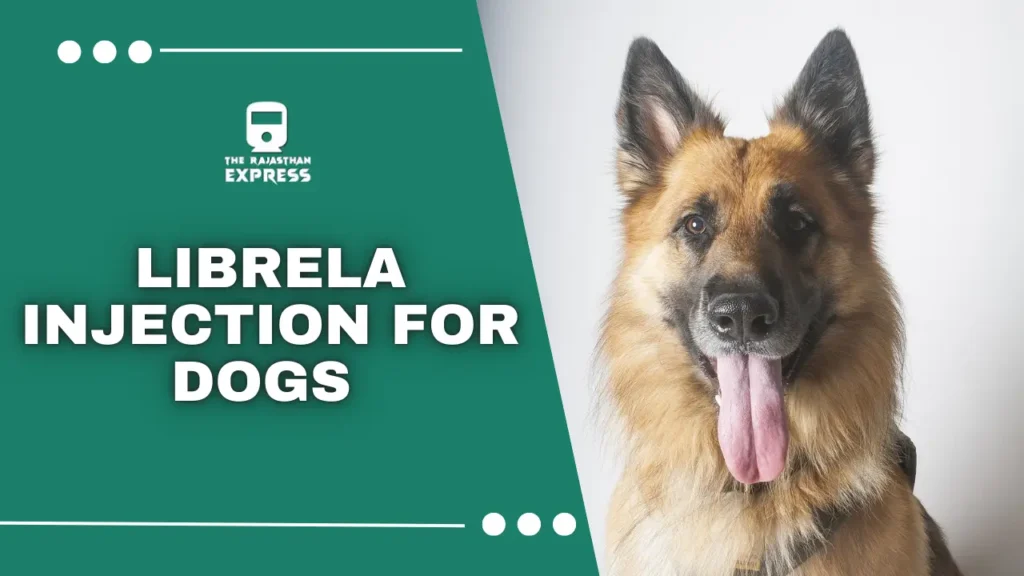
How Solensia Injection Helps with Joint Pain in Cats
Solensia injection contains the salt frunevetmab, which is a monoclonal antibody (mAb). This antibody is a type of protein that helps reduce pain associated with osteoarthritis or arthritis in cats. The monoclonal antibody (mAb) recognizes and binds to a protein known as the Nerve Growth Factor (NGF). NGF helps in the development and growth of nerve cells, but it also acts as an inflammatory mediator during body injuries and increases the sensation of pain.
When the monoclonal antibody (frunevetmab) binds to NGF, it prevents the pain signals from reaching the brain.
Importance of Librela and Solensia:
Librela is the first monoclonal antibody (mAb) used for treating pain associated with osteoarthritis or arthritis in dogs. On the other hand, Solensia (frunevetmab injection) is the first treatment for pain related to osteoarthritis or arthritis in cats.
Both of these medications are manufactured by the same company, Zoetis Inc., a company renowned for developing new and effective medications in veterinary medicine.
Librela Injection for Dogs
| Brand Name | Librela |
|---|---|
| Chemical Name | Bedinvetmab |
| Approval Date | May 5, 2023 (By- U.S. FDA (Food and Drug Administration)) |
| Dosage | 0.23 mg/lb (0.5 mg/kg) once a month |
| Dosage Form | Injectable Solution |
| Dosage Route | Subcutaneous (S/C) |
| Indication | Treatment of pain associated with osteoarthritis in dogs |
| Available Strengths | 5 mg/ml, 10 mg/ml, 15 mg/ml, 20 mg/ml, 30 mg/ml |
| Manufacturer | Zoetis Inc. |
| Mechanism of Action |
|
| Duration of Effect | Long-lasting effects; administered monthly |
| Species | Dogs |
| Launch Date | July 14, 2023 |
| Key Benefits |
|
| The Rajasthan Express: Comprehensive Information on Librela Injection For Dogs | |
Librela Injection for Dogs Comprehensive Information
- Brand Name: Librela
- Chemical Name: Bedinvetmab
- Approval Date: May 5, 2023
- Dosage: Once a month, administered subcutaneously at 0.23 mg/lb (0.5 mg/kg) based on body weight.
- Dosage Form: Injectable Solution
- Dosage Route: Subcutaneous Route (S/C) (under the skin of dogs)
- Species Indicated For Use: Only dogs (This drug is specifically for reducing pain associated with osteoarthritis in dogs.)
- Available Strengths: 5, 10, 15, 20, and 30 mg/ml.
- Manufacturer: Zoetis Inc.
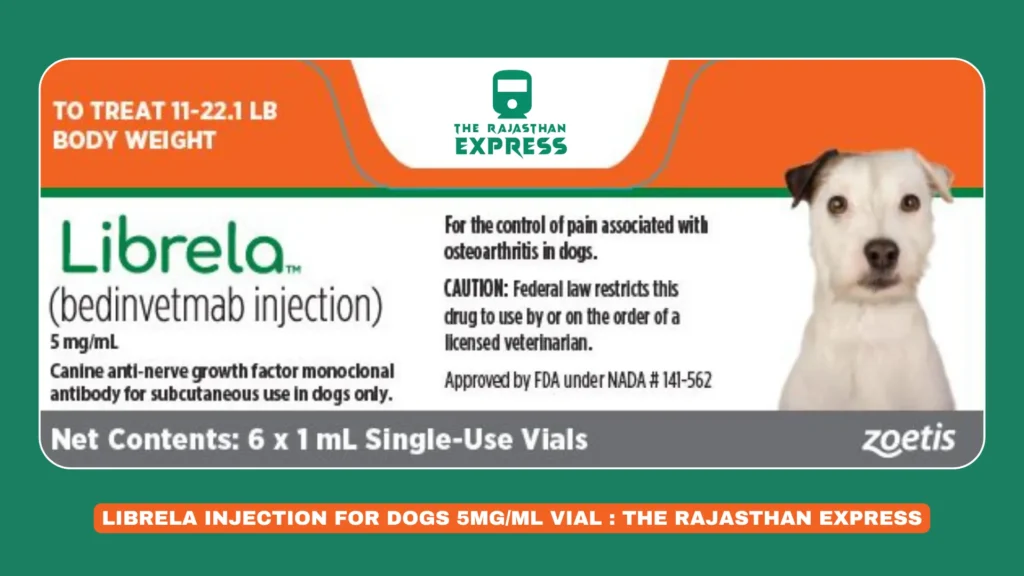
Mechanism of Action of Librela Injection in Dogs :
- Librela is a monoclonal antibody (mAb) that is produced in a laboratory. It is a type of protein. The monoclonal antibody (mAb) recognizes and binds to a protein called Nerve Growth Factor (NGF).
- Nerve Growth Factor (NGF): NGF helps in the development and growth of nerve cells, but during injury, it acts as an inflammatory mediator and increases the sensation of pain.
- When the monoclonal antibody (Bedinvetmab) binds to NGF, it prevents the pain signals from reaching the brain.
Duration of Effect:
- Bedinvetmab injection (Librela Injection) is administered once a month under the skin of the dog. The drug stays in the body for an extended period and has long-lasting effects. Its effects begin to show a few days after the first injection or once the drug is fully absorbed from the skin.
- Therefore, this drug is comfortable and effective for dogs as it provides long-term effects and does not require repeated injections.
What is the use of Librela injection in dogs?
Librela, also known as Bedinvetmab, is a monoclonal antibody (mAb) that is used for the treatment of pain associated with osteoarthritis (OA) or arthritis in dogs over the age of 1 year. This injection is administered subcutaneously (under the skin) in dogs, with a dosage of 0.23 mg/lb (0.5 mg/kg) based on the dog’s body weight.
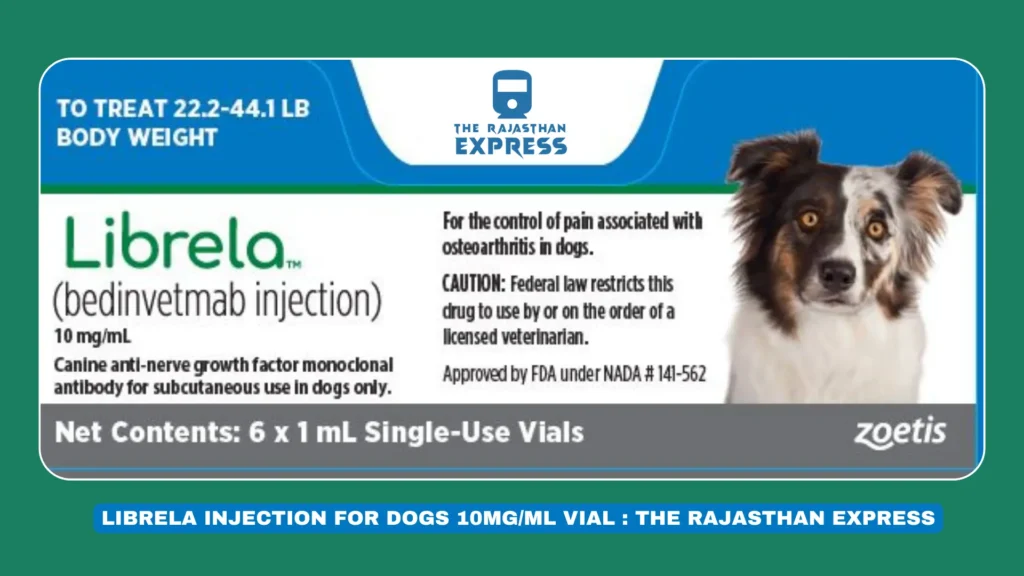
How is Librela useful?
Librela is the first monoclonal antibody (mAb) developed to treat osteoarthritis (OA) or arthritis pain in dogs. Prior to this, no such monoclonal antibody treatment was available for dogs.
Additionally, Solensia (Fruvemetmab) injection is the first treatment for osteoarthritis-related pain in cats.
How does the monoclonal antibody work?
The monoclonal antibody in Librela is a type of protein that recognizes and binds to Nerve Growth Factor (NGF). NGF aids in the growth and development of nerve cells but acts as an inflammatory mediator during injuries, which increases pain perception.
When the monoclonal antibody binds to NGF, it prevents pain signals from reaching the brain, providing relief to the dog.
Market Launch:
Librela was launched in 2023 and represents a significant step in the treatment of osteoarthritis and arthritis in dogs, offering an effective and safe alternative.
Osteoarthritis (OA)
Osteoarthritis, also known as arthritis, is a chronic, progressive joint disease commonly found in dogs and large animals, especially in older ones. The disease leads to the wearing down of the cartilage between joints, causing pain during movement and urination.
The joints are lubricated by a fluid called synovial fluid, which reduces friction and keeps the joints smooth. As animals age, the quantity of synovial fluid decreases, leading to joint stiffness and the wear and tear of bones.
Treatment for Osteoarthritis (OA):
Osteoarthritis (OA) is commonly seen in older dogs but can also affect dogs with obesity or other orthopedic issues. OA is a painful and gradually worsening condition, caused by the breakdown of joint cartilage. While there is no complete cure, several treatments can help manage pain.
- Carprofen: A non-steroidal anti-inflammatory drug (NSAID) that helps reduce inflammation and pain, commonly used in the treatment of OA.
- Meloxicam: Another NSAID that reduces inflammation and pain, particularly helpful for joint pain caused by OA.
New Drug: Librela (Bedinvetmab Injection):
Recently introduced, Librela is a new drug that is particularly effective for treating osteoarthritis pain in dogs. It uses monoclonal antibody technology to target and bind to NGF, blocking the pain signals from reaching the brain and providing relief.
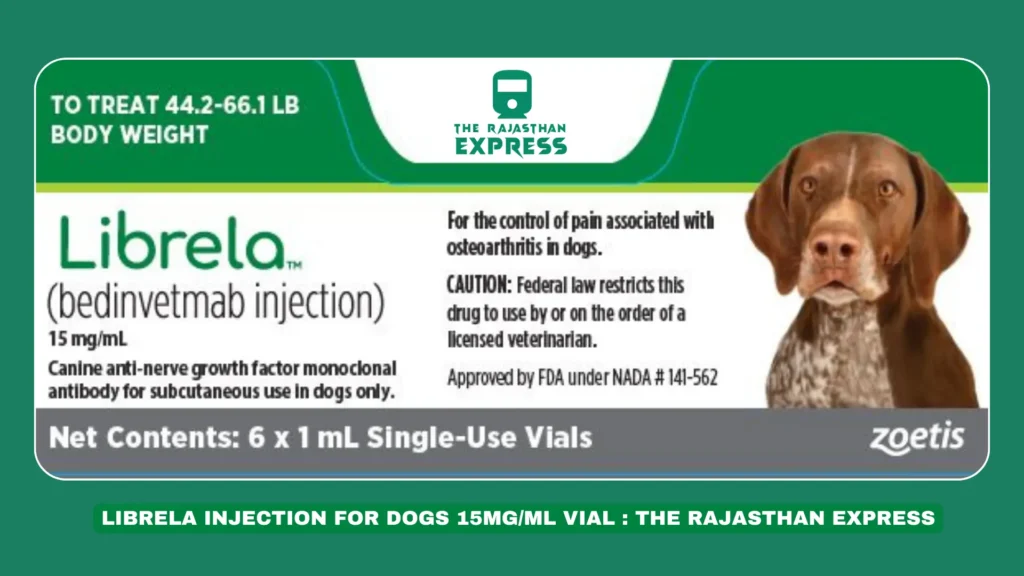
Why is this drug important?
Librela uses monoclonal antibody technology to treat OA pain, offering a new and effective method compared to traditional treatments. It provides relief to dogs suffering from OA pain and became available in the market in 2023.
Symptoms of Osteoarthritis:
The symptoms of osteoarthritis vary depending on the number of affected joints and the severity of the disease. Common symptoms include:
- Pain and stiffness in joints.
- Limping while walking.
- Difficulty climbing or jumping.
Librela Dosing Chart for Dogs
Dosage and Administration:
- Dosage Formula: 0.23 mg/lb (0.5 mg/kg) based on the dog’s weight.
- Route: Subcutaneous Route (S/C).
- Frequency: Administered only once a month.
Dosing Characteristics:
- Long-Lasting Effect:
- The subcutaneous injection is absorbed gradually into the body.
- It remains active for an extended period, providing prolonged pain relief for the dog.
- Single-Use:
- Librela Injection does not contain any preservatives.
- Each vial is intended for single use only.
| The Rajasthan Express: Librela Dosing Chart for Dogs | ||||||
| Dog Body Weight (lb) | Dog Body Weight (kg) | 5 mg/mL (Orange) | 10 mg/mL (Blue) | 15 mg/mL (Green) | 20 mg/mL (Gold) | 30 mg/mL (Purple) |
|---|---|---|---|---|---|---|
| 11-22.1 | 5-10 | 1 vial | ||||
| 22.2-44.1 | 10.1-20 | 1 vial | ||||
| 44.2-66.1 | 20.1-30 | 1 vial | ||||
| 66.2-88.2 | 30.1-40 | 1 vial | ||||
| 88.3-132.3 | 40.1-60 | 1 vial | ||||
| 132.4-176.4 | 60.1-80 | 2 vials | ||||
| 176.5-220.5 | 80.1-100 | 1 vial | 1 vial | |||
| 220.6-264.6 | 100.1-120 | 2 vials | ||||
| The Rajasthan Express: Librela Dosing Chart for Dogs | ||||||
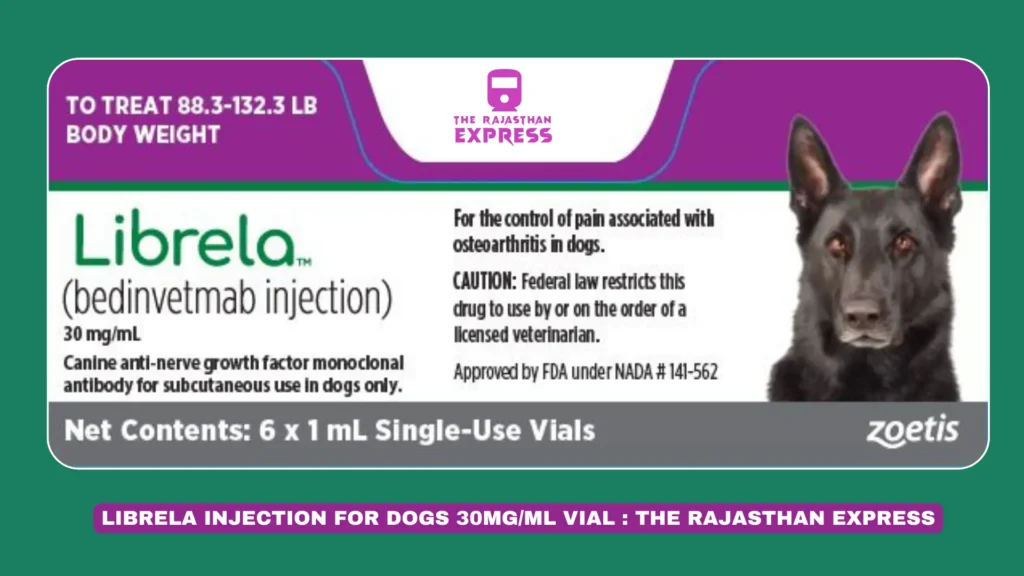

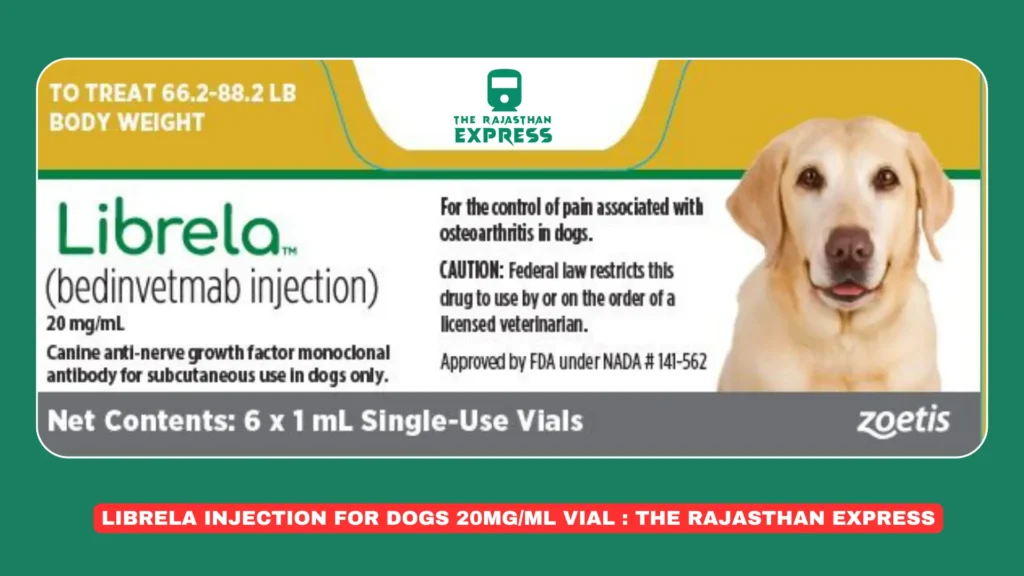


Precautions of Librela Injection For Dogs
When using Librela Injection, it is crucial to consider the dog’s age and health status, especially if the dog is already suffering from any pre-existing condition. Consulting a veterinarian before using this medication is necessary. Additionally, it is important to ensure that Librela Injection does not cause any adverse reactions when used alongside other medications, such as NSAIDs (Carprofen, etc.).
There is currently limited research on the long-term use of this medication in dogs and its effects under various special circumstances. Information on the adverse effects of Librela Injection and its use in other conditions is also limited, as studies are still ongoing.
This medication should not be used without the advice of a veterinarian. It is essential to properly evaluate the dog’s health condition and any potential interactions with other medications.
1. Hypersensitivity:
Side Effects: The use of Bedinvetmab injection or monoclonal antibodies for the first time may result in hypersensitivity and reactions like anaphylaxis. In such cases, the following symptoms may be observed in dogs:
- Itching
- Redness of the skin
- Difficulty breathing
- Low blood pressure (Low B.P)
- Vomiting and diarrhea
- Dizziness
- Loss of consciousness
- Restlessness
- Seizures
Discontinue Treatment: In such cases, immediately discontinue the medication and contact a veterinarian without delay.
Treatment: Treat with medications such as antihistamines and adrenaline (epinephrine). Seek immediate medical emergency services if the animal’s condition is severe.
2. Use with Other Antibodies:
Safety Not Evaluated: The safety of using this medication with other monoclonal antibodies has not been evaluated yet.
Use Cautiously:
If the dog has previously experienced sensitivity to immunoglobulin therapy, this medication should be used with special caution.
4. Vaccine Reactions:
Study Unavailable: No tests have been conducted yet to determine how this monoclonal antibody reacts with other animal vaccines.
It is necessary to consult with a veterinarian about the potential effects of vaccination and medication.
5. Antibody Formation:
Prevention: The use of Bedinvetmab injection or monoclonal antibody medications may cause the dog’s body to form anti-Bedinvetmab antibodies.
Effect of Reaction: After the formation of these antibodies, if the monoclonal antibody enters the body again, the dog’s immune system recognizes it as an infection and reacts against it.
Impact: In this situation, the dog’s body tries to reduce or destroy the effect of the medication, resulting in decreased effectiveness of the treatment.
6. Use with NSAIDs:
Safety Unknown: The use of Bedinvetmab injection (Librela) with NSAIDs (Non-Steroidal Anti-Inflammatory Drugs), such as carprofen, is not considered safe.
Typically, NSAIDs like carprofen are used to reduce pain in osteoarthritis or arthritis.
If NSAIDs and Bedinvetmab injection are used together, i.e., mixed treatment, the risks may increase rather than decrease.
Veterinarians are advised to avoid this combination.
Lessons from Human Trials:
In humans, rapidly progressing osteoarthritis (RPOA) has been observed in cases receiving long-term treatment with NSAIDs and anti-NGF monoclonal antibodies. However, RPOA (reversible post-operative osteoarthritis) has not been reported or identified in dogs so far.
However, such reactions have not been reported in dogs.
7. Age Limit:
No Testing in Dogs under 12 Months:
The use of Librela (Bedinvetmab injection) in dogs under 12 months of age has not been evaluated for safety or effectiveness.
Therefore, it is advised to avoid using this medication in young dogs.
Consultation with a veterinarian before use is necessary.
8. Knee Ligament Issues:
Not Included:
Dogs with cruciate ligament (ACL) issues within the past 6 months have not been tested with Librela (Bedinvetmab injection).
Cruciate ligament issues cause instability in the knee joint of dogs, leading to limping, pain, and arthritis-like problems.
Therefore, this medication should be used cautiously and under veterinary advice in dogs with a history of this issue.
9. Long-Term Effects:
Unknown Effects: Adverse effects after prolonged use (over 9 months) have not been studied.
10. Heart Disease and NGF:
Long-Term Effects: The long-term effects of reducing NGF during heart disease in dogs are unknown.
11. Effect of High Dosage of Medication:
Change: The use of a high dose of Librela (Bedinvetmab injection) in dogs has shown a reduction in the size of neurons.
However, this effect was reversed after discontinuing the medication, meaning it was temporary and ceased after stopping the drug.
This event is related to the high dosage use, so the medication should only be used at the prescribed dosage, and any unexpected effects should be consulted with a veterinarian.
12. Effects on Developing Dogs:
Caution: NGF (Nerve Growth Factor) is involved in the normal development of the Somatic Nervous System (SONS) and the Autonomic Nervous System (ANS) in growing animals.
During the use of Librela, young and growing dogs may experience issues in the development of the ANS and SONS because this medication can impact the developing nervous system.
Both the Somatic Nervous System (SONS) and the Autonomic Nervous System (ANS) are parts of the Peripheral Nervous System (PNS).
The Somatic Nervous System (SONS) controls voluntary physical activities, such as muscle movements.
The Autonomic Nervous System (ANS) controls involuntary activities, such as heartbeats and respiration, and is divided into two parts:
- Sympathetic Nervous System (SNS): Activates the body in stressful or emergency situations.
- Parasympathetic Nervous System (PNS): Keeps the body in a relaxed state.
Caution: Any disruption in the normal development of these nerves may affect the physical functions of the dogs, so special care should be taken when using this medication in developing dogs.


Potential Adverse Reactions from the Use of LIBRELA
The safety of LIBRELA Injection was evaluated in a controlled 84-day study that investigated its effectiveness in reducing pain associated with osteoarthritis (arthritis). The study involved 272 dogs, with 135 dogs receiving LIBRELA and 137 dogs receiving a negative control (only saline).
Study Details:
- A total of 272 dogs were included in the study.
- 135 dogs were treated with LIBRELA.
- 137 dogs were given a negative control (sterile saline).
- Age of the dogs: At least 1 year old (ranging from 1 to 17 years).
- Weight: From 1.8 to 62.7 kilograms.
- Breeds: Various breeds and mixed-breeds.
- Dosage: A maximum of three injections were given at 28-day intervals.
Common Side Effects: The common side effects reported during the study included skin irritation, vomiting, weight loss, and urinary infections.
| Number (%) of Dogs with Adverse Reactions Reported in the US Field Study | ||
| Adverse Reaction | LIBRELA (n = 135) | Negative Control (n = 137) |
|---|---|---|
| Urinary tract infection | 15 (11.1%) | 11 (8.0%) |
| Bacterial skin infection | 11 (8.1%) | 9 (6.6%) |
| Dermatitis | 10 (7.4%) | 8 (5.8%) |
| Dermal mass | 8 (5.9%) | 5 (3.6%) |
| Erythema | 6 (4.4%) | 5 (3.6%) |
| Dermal cyst(s) | 4 (3.0%) | 2 (1.5%) |
| Pain on injection | 4 (3.0%) | 2 (1.5%) |
| Inappropriate urination** | 4 (3.0%) | 1 (0.7%) |
| Histiocytoma | 3 (2.2%) | 0 (0.0%) |
| The Rajasthan Express : Librela Injection for Dogs | ||
Important Points:
- A dog may experience adverse effects more than once, but only the first occurrence of the event was counted in this study.
- Two dogs treated with LIBRELA reported urinary tract infections.
| Number (%) of Dogs with Adverse Reactions Reported in the European Field Study | ||
| Adverse Event Reported | LIBRELA (n = 138) | Negative Control (n = 143) |
|---|---|---|
| Increased Blood Urea Nitrogen (BUN)** | 19 (13.8%) | 7 (4.9%) |
| Lethargy | 5 (3.6%) | 0 (0.0%) |
| Emesis | 4 (2.9%) | 1 (0.7%) |
| Anorexia | 3 (2.2%) | 0 (0.0%) |
| Lameness | 3 (2.2%) | 1 (0.7%) |
| Cough | 3 (2.2%) | 1 (0.7%) |
| The Rajasthan Express : Librela Injection for Dogs | ||
Notes:
- Adverse effects may occur more than once in a dog; only the first occurrence was recorded.
Severe Adverse Effects and Euthanasia:
- 13-Year-Old Bichon Frise Female Dog:
The dog had pre-existing abnormalities in the urine protein-creatinine ratio and heart failure.
Her condition worsened during the study.
An increase in creatinine levels and kidney failure were detected.
She was humanely euthanized three days after the study ended. - 8-Year-Old Mixed-Breed Dog:
The dog had a history of pancreatitis (inflammation of the pancreas).
On day 74, her condition worsened, leading to her being humanely euthanized.
Observation of Other Cases:
- In dogs with elevated BUN (Blood Urea Nitrogen) levels, no adverse effects related to this increase were observed.
One dog from the LIBRELA group:
On Day 15, pyelonephritis (inflammation of the kidneys) was detected.
This dog had pre-existing elevated BUN and creatinine levels and had a history of urinary tract infections (UTI).
Injection Site Issues:
One dog experienced alopecia (hair loss) and skin redness at the injection site, which resolved after treatment.
Adverse Events Categorized by Body Systems
- Neurologic: Ataxia, seizures, paralysis, proprioceptive deficits.
- General: Loss of appetite, lethargy, lying down.
- Kidney/Urinary System: Excessive thirst, frequent urination, urinary incontinence.
- Gastrointestinal: Vomiting, diarrhea.
- Musculoskeletal: Muscle weakness, tremors, limping.
In some cases, these adverse events resulted in death (or euthanasia).
Additionally, it is recommended that dog owners be informed about potential adverse reactions following the administration of LIBRELA.
What to Do If Side Effects Occur from LIBRELA Injection?
Report Immediately:
- If any side effects are observed during the use of LIBRELA, report them immediately to Zoetis and the FDA. This allows for a thorough study of the side effect and the identification of appropriate solutions.
Report to Zoetis:
- Zoetis is the manufacturer of LIBRELA.
- Call Zoetis at 1-888-963-8471 to report any side effects.
- Zoetis is required to report all side effects to the FDA.
Report Directly to the FDA:
- Visit the official FDA website at www.fda.gov/reportanimalae to submit a side effect report.
Include the Following Information in the Report:
- The dog’s complete medical history.
- How many times the dog was administered the LIBRELA injection.
- The dog’s age and any pre-existing conditions.
- The lot number of the vial used.
Analysis Results
As of April 18, 2024, a total of 3,674 cases related to Librela™ had been recorded in the CVM database, with reports received by March 31, 2024. Of these 3,674 cases, 3,637 cases were reported in dogs.
| Age Distribution for Librela™ Compared to All Other Cases Reported in Dogs | ||||
| Age Group Category | Librela™ (Number of Cases) | Librela™ (%) | All Other Cases (Number of Cases) | All Other Cases (%) |
|---|---|---|---|---|
| Unknown | 348 | 9.6% | 66,358 | 7.6% |
| < 1 year | 5 | 0.1% | 94,040 | 10.8% |
| 1 through 5 years | 108 | 3.0% | 377,720 | 43.2% |
| 6 to 10 years | 524 | 14.4% | 181,505 | 20.8% |
| ≥ 10 years | 2,652 | 72.9% | 154,450 | 17.7% |
| Grand Total | 3,637 | 100% | 874,073 | 100% |
| The Rajasthan Express: Librela Injection for Dogs | ||||
Key Points:
- The majority of cases related to Librela™ (72.9%) were found in dogs aged 10 years or older.
- In all other cases, the percentage of dogs aged 1 to 5 years (43.2%) was higher.
- The percentage of cases with unknown age was slightly higher for Librela™ (9.6%) compared to other cases (7.6%).
“Discover everything about Librela injection for dogs, including its uses, benefits, and possible side effects. Learn how it helps in managing pain and improving mobility in dogs.”
THE RAJASTHAN EXPRESS
Frequently Asked Questions about Librela Injection for Dogs
What is Librela for Dogs?
What is the dosage of Librela for Dogs?
How does Librela work?
Is Librela safe for dogs?
How long does Librela take to work?
Is Librela a steroid?
Why is Librela effective?
- Subcutaneous Absorption: The injection is administered under the skin, allowing slow and steady absorption.
- Gradual Impact: The medication progressively binds to NGF, blocking pain and inflammation signals to the brain.
- Long-Lasting Relief: With monthly administration, it provides sustained pain relief over time.

